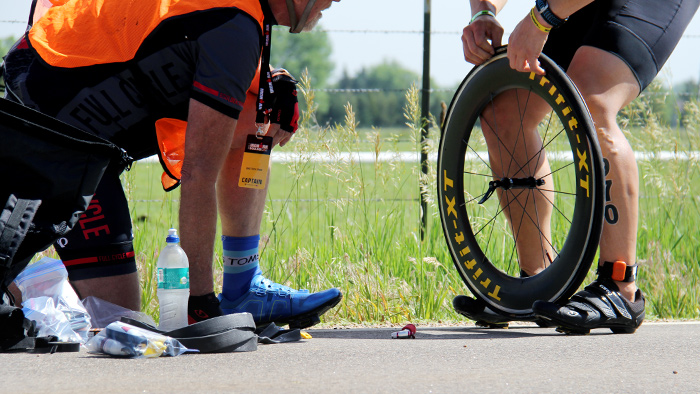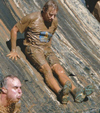The week before an IRONMAN or IRONMAN 70.3 can be very stressful. There’s so much you need to do, and yet, at the same time you know you need to be resting up for the big demands of the day. Here is a check list of the seven things you should do to help you sort out the “musts” from the “maybe after a nap” pre-race demands.
1. Get Your Bike Race Ready.
Not a great bike mechanic? Me either. Consider having your local guys check out your steed, and keep in mind that if you’re traveling for the race this might need to be scheduled well in advance. Bike shop guys/gals are inherently fun, easy to talk to, and you might learn something new. What is the cost of this compared to the mental cost of a broken chain at mile 10 on the bike course? I’ve never had a bike related issue in any triathlon, ever, simply by following this recommendation.
If you have had your bike shipped to the event, make sure either you or a qualified mechanic has a chance to make sure everything is in working order once it’s re-assembled. Plan at least a few quick rides in varying gears to make sure shifting/braking are working properly.
2. Practice Your Transitions.
It always baffles me when guys in my age group spend double, even triple the amount of time I do in transition and wonder why their race times don’t improve.
Review the swim, bike and run transition area(s) of your IRONMAN. If the race site isn’t too far away, drive over there and go over the even site, maybe even simulate a swim entry/exit and make note of where the bike and run exits will be.
Also practice with what you know you’ll have with you on race day. For example, get a few practice runs of pulling off that wetsuit while slightly fatigued (not all races have those lovely wetsuit removers!), and practice stuffing whatever fuel you’ll have on you in all the right pockets, etc.
The more realistic your transition simulation can be, the faster you will be on race day.
3. Finalize Your Nutrition Logistics.
Your nutrition strategy is technically something you should’ve been working on during much of your training, but the logistics of what you’ll need on race day are different. Purchase everything you’ll need from the minute you wake up on race day all the way through what you want to have on hand post-race. Have a plan for when/how much you’ll eat (based on what you’ve done in training and had success with) and be diligent with it.
4. Finalize Your Hydration Logistics.
Much like with fueling, your hydration strategy should not be something you are experimenting with or guessing about) on race day. Hydration logistics involve the actual process you will use on race day, in addition to how much fluid you need to obtain (or purchase) before race morning.
Do you know your sweat rate? Are you a drink-to-thirst athlete or one who goes on more of a schedule? How will you keep track of what you consume on the bike? Have you ever peed on a moving bike? Is that a skill you need/want to master? All of these are important questions to know the answers to before you line up to race.
5. Plan Your Post-Race Logistics.
While you’ll be on cloud nine after crossing that finish line, the endorphins will soon settle, leaving you tired, hungry and grumpy if you don’t have a post-race plan. Plus there are your spectators to consider. Make a plan pre-race of where you will meet (sometimes finish lines are the best place, but sometimes not), what they should bring you, and where you’ll go from there.
What will you eat? What clothes/shoes will you change into? If you do well in your age group, will you wait around for the awards ceremony? It could be quite some time after you finish; do you have sunscreen?
6. Familiarize yourself with the course.
If you are doing a local race, then you’ve likely had the opportunity to ride and run the course as part of your race preparation, but if you’re traveling to the race venue course familiarization is essential. Take some time to swim during the open water practices and see if you’ll need an extra cap due to cold water or possibly a skin suit if the swim might not be wetsuit legal.
Drive the entire bike course and make note of any good areas to refuel, spin out your legs and sit up for a bit, or really power down on the pedals for a stretch. Familiarize yourself as to where the hills and aid stations will be on the run and plan your run attire accordingly.
During all your pre-race sessions remember: You are a guest of the people of your race’s venue, so please respect and obey the traffic laws during your training practices.
7. Prepare (but don’t obsess!) over the major what-ifs.
Do you have any idea what would happen if you got injured? Do you know where the med tent is? Does your family know where you should meet if for some reason you end up with a DNF? Make sure you fill out all the necessary medical info on the back of your race bib, it’s a simple step that is incredibly helpful for medical responders in the unlikely event that something should happen to you during the race.
Do you know where the timing table is should you lose your chip? It happens. In Kona, they think this is important enough that they not only have an entire page of the pre-race guide devoted to it, they place the timing table (where replacement chips are available) at the swim exit, bike exit and run exit.
These aren’t all of the things you’ll need to do before race day, of course you might have bike check-ins the day before, and/or a mandatory race meeting to attend as well. But if you follow these seven tips you’ll be in a better position to have a fun and rewarding day.
Athletes’ Choice Winner: Triathlon
This article was one of the most popular on TrainingPeaks in 2018. To see all the winners, visit the Athletes’ Choice 2018 Page.



